Aleksander Ficek
Nemotron-H: A Family of Accurate and Efficient Hybrid Mamba-Transformer Models
Apr 10, 2025Abstract:As inference-time scaling becomes critical for enhanced reasoning capabilities, it is increasingly becoming important to build models that are efficient to infer. We introduce Nemotron-H, a family of 8B and 56B/47B hybrid Mamba-Transformer models designed to reduce inference cost for a given accuracy level. To achieve this goal, we replace the majority of self-attention layers in the common Transformer model architecture with Mamba layers that perform constant computation and require constant memory per generated token. We show that Nemotron-H models offer either better or on-par accuracy compared to other similarly-sized state-of-the-art open-sourced Transformer models (e.g., Qwen-2.5-7B/72B and Llama-3.1-8B/70B), while being up to 3$\times$ faster at inference. To further increase inference speed and reduce the memory required at inference time, we created Nemotron-H-47B-Base from the 56B model using a new compression via pruning and distillation technique called MiniPuzzle. Nemotron-H-47B-Base achieves similar accuracy to the 56B model, but is 20% faster to infer. In addition, we introduce an FP8-based training recipe and show that it can achieve on par results with BF16-based training. This recipe is used to train the 56B model. All Nemotron-H models will be released, with support in Hugging Face, NeMo, and Megatron-LM.
OpenCodeInstruct: A Large-scale Instruction Tuning Dataset for Code LLMs
Apr 05, 2025Abstract:Large Language Models (LLMs) have transformed software development by enabling code generation, automated debugging, and complex reasoning. However, their continued advancement is constrained by the scarcity of high-quality, publicly available supervised fine-tuning (SFT) datasets tailored for coding tasks. To bridge this gap, we introduce OpenCodeInstruct, the largest open-access instruction tuning dataset, comprising 5 million diverse samples. Each sample includes a programming question, solution, test cases, execution feedback, and LLM-generated quality assessments. We fine-tune various base models, including LLaMA and Qwen, across multiple scales (1B+, 3B+, and 7B+) using our dataset. Comprehensive evaluations on popular benchmarks (HumanEval, MBPP, LiveCodeBench, and BigCodeBench) demonstrate substantial performance improvements achieved by SFT with OpenCodeInstruct. We also present a detailed methodology encompassing seed data curation, synthetic instruction and solution generation, and filtering.
OpenCodeReasoning: Advancing Data Distillation for Competitive Coding
Apr 02, 2025Abstract:Since the advent of reasoning-based large language models, many have found great success from distilling reasoning capabilities into student models. Such techniques have significantly bridged the gap between reasoning and standard LLMs on coding tasks. Despite this, much of the progress on distilling reasoning models remains locked behind proprietary datasets or lacks details on data curation, filtering and subsequent training. To address this, we construct a superior supervised fine-tuning (SFT) dataset that we use to achieve state-of-the-art coding capability results in models of various sizes. Our distilled models use only SFT to achieve 61.8% on LiveCodeBench and 24.6% on CodeContests, surpassing alternatives trained with reinforcement learning. We then perform analysis on the data sources used to construct our dataset, the impact of code execution filtering, and the importance of instruction/solution diversity. We observe that execution filtering negatively affected benchmark accuracy, leading us to prioritize instruction diversity over solution correctness. Finally, we also analyze the token efficiency and reasoning patterns utilized by these models. We will open-source these datasets and distilled models to the community.
Scoring Verifiers: Evaluating Synthetic Verification in Code and Reasoning
Feb 19, 2025Abstract:Code verification has recently found great success as a critical component in training large scale reasoning models for coding. Synthetic techniques such as self-generated test cases and reward models provide a way to enhance code capabilities beyond predefined tests. Building on these advancements, we propose new benchmarks designed to systematically evaluate the impact of synthetic verification methods on assessing solution correctness. We introduce HE-R, HE-R+, MBPP-R, and MBPP-R+, which transform existing coding benchmarks into scoring and ranking datasets to evaluate the effectiveness of synthetic verifiers. Using these benchmarks, we analyze synthetic verification methods in standard, reasoning-based, and reward-based LLMs. Our results show that recent reasoning models significantly improve test case generation and that scaling test cases enhances verification accuracy.
Genetic Instruct: Scaling up Synthetic Generation of Coding Instructions for Large Language Models
Jul 29, 2024
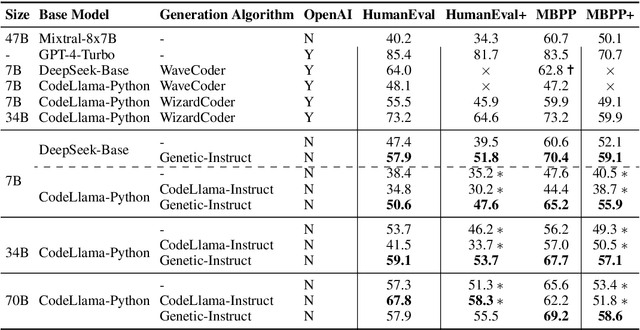
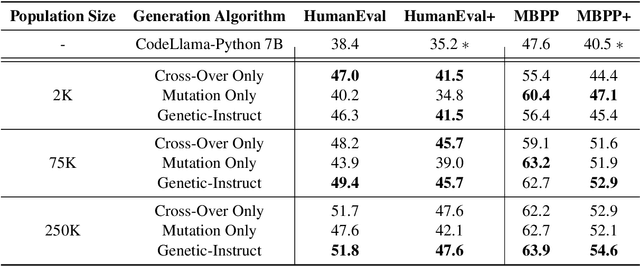
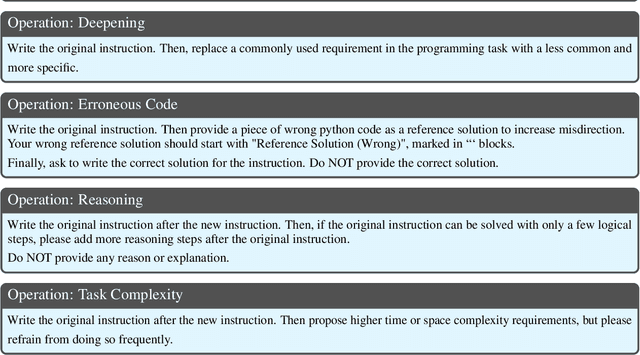
Abstract:Large Language Models (LLMs) rely on instruction samples for alignment, but creating these datasets poses challenges, particularly in expert-dependent tasks like coding, which can be cost-prohibitive. One approach to mitigate these challenges is synthesizing data using another LLM. In this paper, we introduce a scalable method for generating synthetic instructions to enhance the code generation capability of LLMs. The proposed algorithm, Genetic-Instruct, mimics evolutionary processes, utilizing self-instruction to create numerous synthetic samples from a limited number of seeds. Genetic-Instruct is designed for efficient scaling of the generation process. Fine-tuning multiple coding LLMs with the synthetic samples demonstrates a significant improvement in their code generation accuracy compared to the baselines.
GPT vs RETRO: Exploring the Intersection of Retrieval and Parameter-Efficient Fine-Tuning
Jul 05, 2024Abstract:Parameter-Efficient Fine-Tuning (PEFT) and Retrieval-Augmented Generation (RAG) have become popular methods for adapting large language models while minimizing compute requirements. In this paper, we apply PEFT methods (P-tuning, Adapters, and LoRA) to a modified Retrieval-Enhanced Transformer (RETRO) and a baseline GPT model across several sizes, ranging from 823 million to 48 billion parameters. We show that RETRO models outperform GPT models in zero-shot settings due to their unique pre-training process but GPT models have higher performance potential with PEFT. Additionally, our study indicates that 8B parameter models strike an optimal balance between cost and performance and P-tuning lags behind other PEFT techniques. We further provide a comparative analysis of between applying PEFT to an Instruction-tuned RETRO model and base RETRO model. This work presents the first comprehensive comparison of various PEFT methods integrated with RAG, applied to both GPT and RETRO models, highlighting their relative performance.
Nemotron-4 340B Technical Report
Jun 17, 2024



Abstract:We release the Nemotron-4 340B model family, including Nemotron-4-340B-Base, Nemotron-4-340B-Instruct, and Nemotron-4-340B-Reward. Our models are open access under the NVIDIA Open Model License Agreement, a permissive model license that allows distribution, modification, and use of the models and its outputs. These models perform competitively to open access models on a wide range of evaluation benchmarks, and were sized to fit on a single DGX H100 with 8 GPUs when deployed in FP8 precision. We believe that the community can benefit from these models in various research studies and commercial applications, especially for generating synthetic data to train smaller language models. Notably, over 98% of data used in our model alignment process is synthetically generated, showcasing the effectiveness of these models in generating synthetic data. To further support open research and facilitate model development, we are also open-sourcing the synthetic data generation pipeline used in our model alignment process.
How to tackle an emerging topic? Combining strong and weak labels for Covid news NER
Oct 08, 2022
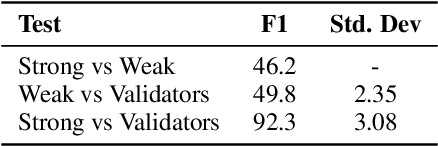

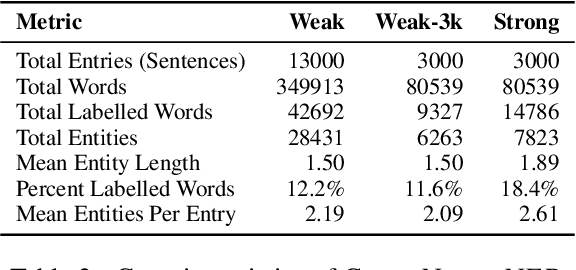
Abstract:Being able to train Named Entity Recognition (NER) models for emerging topics is crucial for many real-world applications especially in the medical domain where new topics are continuously evolving out of the scope of existing models and datasets. For a realistic evaluation setup, we introduce a novel COVID-19 news NER dataset (COVIDNEWS-NER) and release 3000 entries of hand annotated strongly labelled sentences and 13000 auto-generated weakly labelled sentences. Besides the dataset, we propose CONTROSTER, a recipe to strategically combine weak and strong labels in improving NER in an emerging topic through transfer learning. We show the effectiveness of CONTROSTER on COVIDNEWS-NER while providing analysis on combining weak and strong labels for training. Our key findings are: (1) Using weak data to formulate an initial backbone before tuning on strong data outperforms methods trained on only strong or weak data. (2) A combination of out-of-domain and in-domain weak label training is crucial and can overcome saturation when being training on weak labels from a single source.
 Add to Chrome
Add to Chrome Add to Firefox
Add to Firefox Add to Edge
Add to Edge